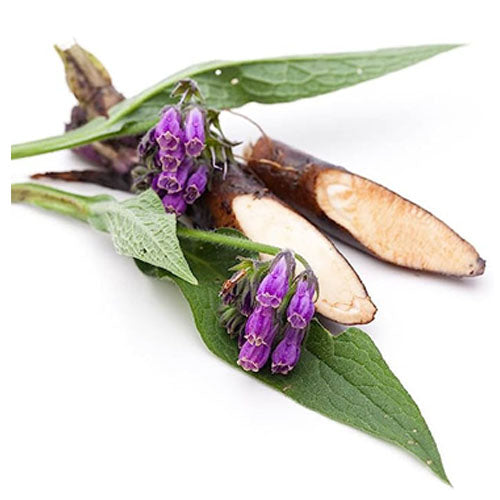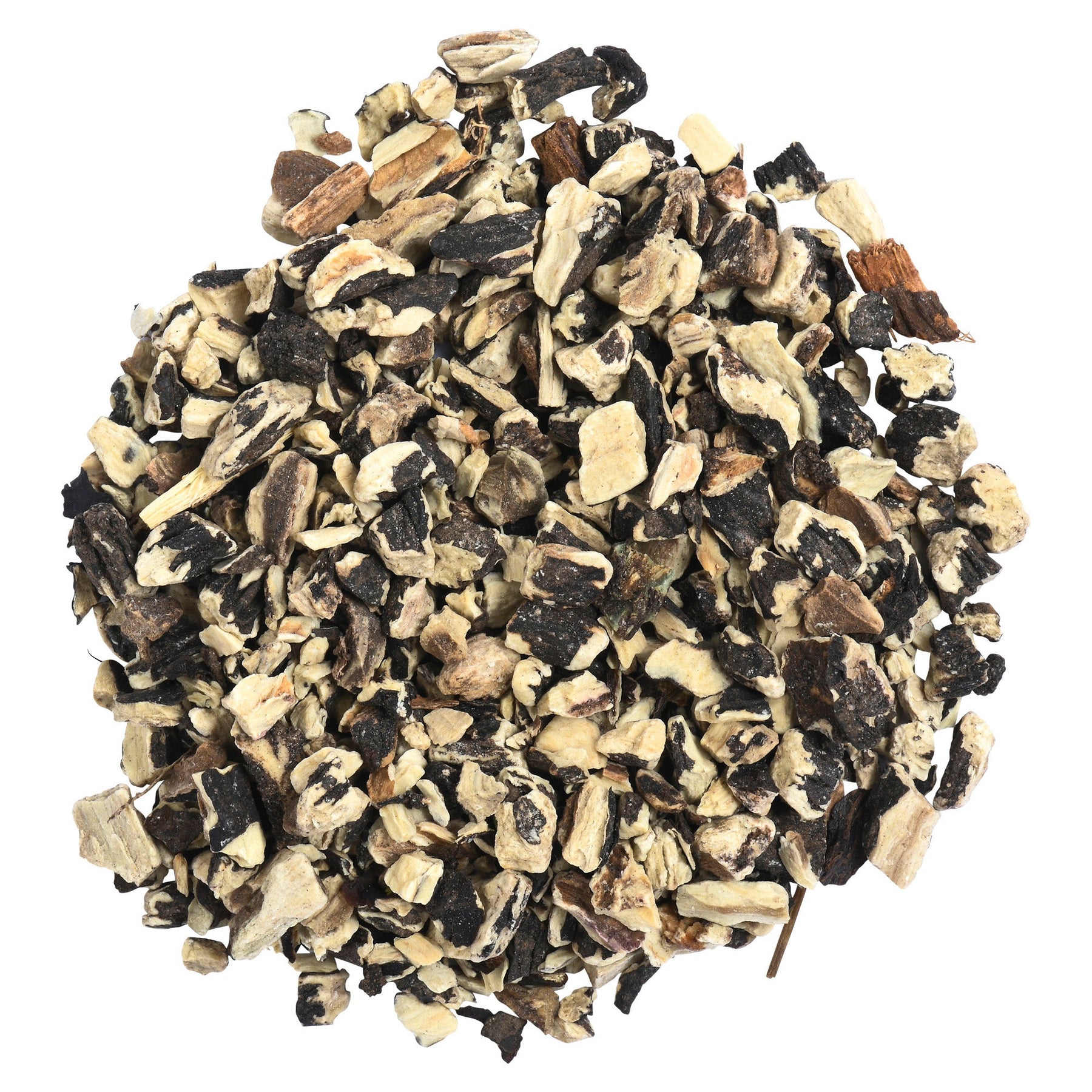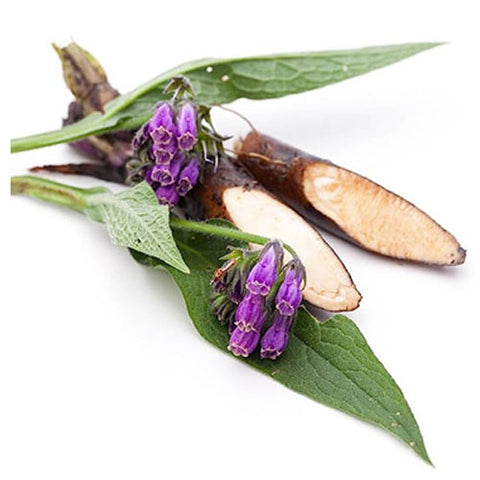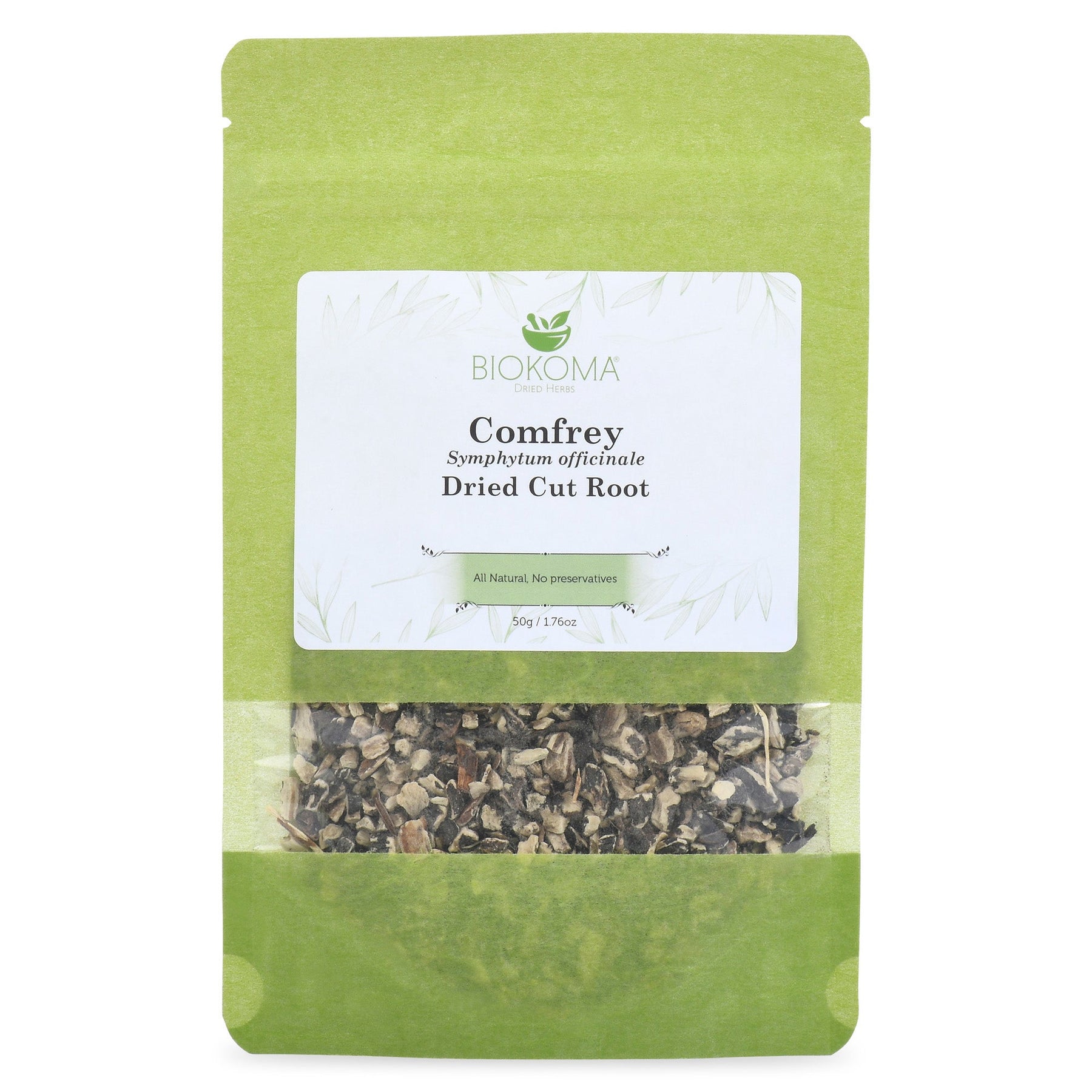5 Skin Benefits of Comfrey Root

From treating minor pains to healing broken bones, the root of the Symphytum officinale plant is one of the most popular herbal medicines used topically.
Found in parts of Asia and Europe, comfrey root is best recognized by its thick, hairy stem and dull purple/blue flowers, which makes this shrub impossible to miss. Along with those features, much can also be said about its short appearance (growing roughly 2 to 5 feet tall).
When used topically, comfrey root is a powerhouse herb for the skin. Here are some common comfrey root skin benefits:
- Targets Back Pain
- Treats Ankle Sprains
- Joint Pain Relief For Arthritis
- Relieves Itchy Skin & Eczema
- Keeps Skin Hydrated and Moisturized
First, let’s look at the connection between comfrey root and back pain.

Benefit #1: Targets Back Pain
Back pain can be caused by different reasons, including spinal or nerve issues, slipped disc and injury. If left untreated or undiagnosed, that pain can worsen over time.
Regardless of what may be causing it, topical use of comfrey root can relieve pain on the upper and lower parts of the back.
In a 2010 study, comfrey root extract was made into an ointment for the treatment of acute back pain. In as little as 1 hour, some participants confirmed that they felt little to no pain in the area. Overall, pain intensity was reduced by 95.2% for the group involved.
When combined with methyl nicotinate, comfrey root was again found to be effective in treating back pain in another study from 2012. Methyl nicotinate is used in treating muscle pain -- But, its pain-relieving properties were enhanced when comfrey root extract was added!
All in all, comfrey root makes for quick and painless treatment for back pain. The same can be said for injuries!
Benefit #2: Treats Ankle Sprains
Traditionally, comfrey root was used to heal a broken limb.
Where casts were not yet available to the everyday man, the roots of the comfrey plant were crushed into a powder and applied to the area as a paste. Once the paste dried, a ‘cast’ would form to protect the area and accelerate healing.
With that in mind, it’s not too hard to believe that comfrey root can treat sprains, too!
An ankle sprain is caused by painfully twisting the joint without it being dislocated. What follows is swelling caused by inflammation to the injured area.
Unlike with treating a broken limb, researchers simply added the comfrey root to an ointment and applied it four (4) times daily for eight (8) days. When applied to acute ankle sprains, according to a 2004 study, the comfrey root ointment reduced pain and edema (ie: swelling).
This finding can be chalked up to Allantoin from the comfrey plant. Found in both the leaves and roots, Allantoin is one of the anti-inflammatory properties that can effectively reduce swelling when used topically.

Benefit #3: Joint Pain Relief For Arthritis
Along with treating back pains and ankle sprains, comfrey root was found to relieve joint pain associated with arthritis and osteoarthritis.
Arthritis is the swelling and tenderness of one or more joints, while osteoarthritis is the most common form of arthritis. Osteoarthritis tends to specifically target joints in the hands, knees, hips and spine.
The link between comfrey root and joint pain treatment was studied (and proven) in 2011.
This study featured 43 participants aged 45-83 who were diagnosed with primary osteoarthritis. Over the course of 6 weeks, comfrey-based creams were applied to their knees 3x daily. The creams were made with 10% and 20% comfrey root extract.
When compared to another cream used, the comfrey-based creams were far more superior in reducing stiffness and pain.
While the damage done to these joints is irreversible, osteoarthritis symptoms like pain, tenderness and swelling can be remedied using comfrey root.
Comfrey root can also be applied to muscle pains, as research has found that it is effective in relieving nerve tension there.
Benefit #4: Relieves Itchy Skin and Eczema
Itchiness is one of the most common conditions to deal with on a day-to-day basis. For those with eczema, for example, 1 in 10 adults are estimated to develop the condition over the course of their lifetime.
Eczema is a condition that leaves dry, itchy patches on the skin. These patches worsen when irritated or as a result of an allergic reaction. Some other symptoms of eczema include:
- Flaky, crusty or scaly skin
- Swelling and inflammation
- Skin rash or bumps on the skin
Given its anti-inflammatory properties, comfrey root’s allantoin nutrient reduces the appearance of swelling associated with itchy skin. Reducing inflammation is one of the steps in lessening itchiness.
Conditions like eczema and atopic dermatitis weaken your skin cells. That results in these skin cells losing moisture and developing gaps or holes under the surface of your skin. Whenever you experience a breakout into bumps or rashes, that is your skin’s reaction to the lack of moisture (ie: dryness or itchiness).
Allantoin helps in generating new skin cells, which improves the skin’s ability to heal itself.
Benefit #5: Keeps Skin Hydrated and Moisturized
Along with relieving inflammation and reducing itchiness, the allantoin from comfrey root doubles as a moisturizing agent.
Some skin care brands use comfrey root extract as a keratinolytic in their creams, lotions and oils. A keratinolytic is used to soften the skin’s outer layer (ie: epidermis). Using comfrey root on the skin can keep skin moist and hydrated.
Another one of the properties found in comfrey root is Rosmarinic acid.
Research has shown UV rays may lead to wrinkles, liver spots and leathery skin. If left unprotected, the damage caused can result in sunburns and even skin cancer in some cases. Known as an antioxidant, Rosmarinic acid protects the skin from UV rays.
With that in mind, how do you use comfrey root on skin?
Creating a salve is the easiest way to reap its skin benefits. Here’s what we recommend you use to make your own comfrey root salve.
Add 1 tsp of ground comfrey root with a few drops of boiled water and a few drops of cooking oil. Mix until these ingredients form a thick paste. Apply on wounds, abrasions, joints and pains, or add to a bandage prior to wrapping an injury.
Along with this salve recipe, you can also consider creating a comfrey root oil or comfrey root cream. The next step in adding comfrey root to your skin care regimen is sourcing the herb.

Where To Buy Comfrey Root For Skin
While it is mostly found in Europe and Asia, you don’t need to reside in either of those places to add this to your collection. Comfrey root can also be bought online here and shipped worldwide.
Each package of comfrey root is picked and packaged by hand, and then dried to keep the roots ready for use when it gets to your doorstep.
Shop your first or next Comfrey (Symphytum Officinale) Dried Cut Root exclusively at Biokoma.
Why Should You Use Comfrey Root (+Final Thoughts)
There are a myriad of comfrey root uses. From healing sprains to moisturizing skin, using comfrey root for skin traditionally was a no-brainer.
However, in recent years, more research has shown that comfrey root still holds some benefit!
Creating a comfrey root salve for back pain or muscle tension can result in relieving the pain associated with injury, nerve issue and tension. The same can be said for joint pain caused by arthritis (or osteoarthritis).
Some studies have highlighted how useful comfrey root is in treating injuries, specifically ankle sprains - Though our ancestors went as far as treating broken bones with the herb, too!
It is widely regarded as one of the best herbs for eczema, but using comfrey for psoriasis and atopic dermatitis is another way to reap its anti-itch benefits. Relieving dryness and itchiness is only one of the benefits of its hydrating properties.
Now that we know the comfrey benefits for skin, it’s time to purchase your very own dried roots. Visit this link to claim Biokoma’s exclusive dried blend.
FDA DISCLAIMER
These statements have not been evaluated by the FDA. These products are not intended to diagnose, treat, cure or prevent any disease. No known precautions. We recommend that you consult with a qualified healthcare practitioner before using herbal products, particularly if you are pregnant, nursing, or on any medications.
REFERENCES
https://pubmed.ncbi.nlm.nih.gov/19460762/
https://www.ncbi.nlm.nih.gov/pmc/articles/PMC3747459/
https://pubmed.ncbi.nlm.nih.gov/15500257/
https://www.mayoclinic.org/diseases-conditions/osteoarthritis/symptoms-causes/syc-20351925
https://www.ncbi.nlm.nih.gov/pmc/articles/PMC3259911/
https://my.clevelandclinic.org/health/diseases/9998-eczema
https://nationaleczema.org/blog/what-is-my-skin-barrier/
https://www.avogel.co.uk/health/skin/amazing-skincare-benefits-comfrey-revealed/






